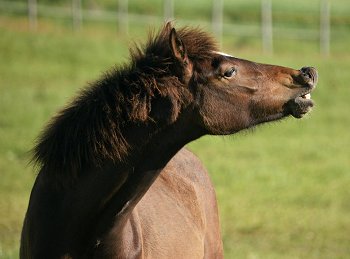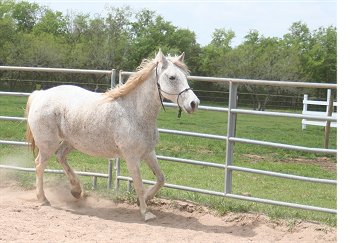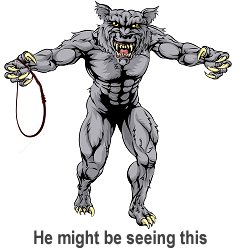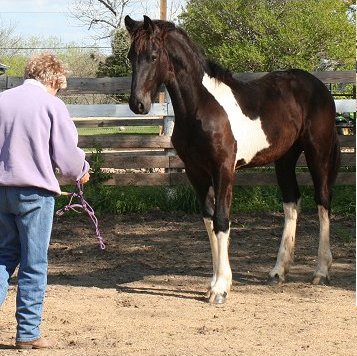 So you can’t catch your horse.
So you can’t catch your horse.
Why do horses run away from their owners?
1. Wild or untrained horses are intimidated or afraid. They need an owner who understands how they view the person approaching through an instinctive prism of fight or flight and they need de-sensitizing training.
2. Horses in a group take cues from other horses who run, again using the “fight or flight” group-think.
3. Poorly trained or poorly handled but savvy horses anticipate an undesirable activity (such as riding with all of its undesirable parts like saddling, bridling, and riding). If removed from a desirable situation like eating grass in a big pasture and taken to work, they can quickly figure out which activity takes more energy. Being inherently lazy, they will choose the former. They need to learn that standing still is more desirable than running away.
4. Some horses have a Lack of Respect for their owner or people in general, fostered by an owner who has not reinforced boundaries or taken a leadership position in the partnership.
Generally it is a combination of some of the reasons above.
I recently received this plea for help, “My horse, though perfectly fine and quiet while tied or in hand, is nasty and completely un-catchable when he is free. He is even too wise to be caught with food. He also shows worrying behavior of charging, purposely trying to kick, and running and bucking. Once you do catch him, he’s fine. The issue is catching him, and staying in one piece while doing it.
All kinds of internet advise has been offered, none of which has really worked very well. It takes over an hour to catch him, and when I do, I only ride him rarely, to ”break the pattern” as many sites have advised. I only stay where I am and brush and pet him. The amount of time I have been doing this with no results, and the amount of work it takes to catch him have me at the end of my rope. Any advice?” signed “Horse Owner”
HI Horse Owner: Maybe this is just one more piece of internet advise, but here goes….
Must you catch in an uncontrolled situation such as a pasture? That makes things nearly impossible to change. He has the advantage every time. He can trot off with little effort while you chase until you drop. You can’t even MAKE him keep running if you wanted to because you can’t get from one end of the pasture to the other before he stops and takes a rewarding bite of grass while you catch up.
Can you keep him in (or run him into) a much smaller area or round pen? In the smaller area you can direct his movements around you without exhausting yourself. If you can run him into a catch-corral or round pen, go into the pen with him and stand there with no pressure so that you both relax. Maybe he can get his daily ration of grain in that pen? Let him see that once he is in the pen, life is easy. It’s a sweet spot. After several minutes, start your approach. If the problem isn’t solved, read further for approaching techniques.
Is he with other horses in a large pasture? If the others run, you are sunk. Try getting ALL of the horses into the catch-corral. From there Pat Parelli proposes that you may be able to use herd psychology to catch one willing horse after another until you can approach and catch your particular horse the same way.
That’s the end of the “easy” solutions. Now set aside at least 2 hours per session of work for formal training. Don’t be in a rush. You can’t rush a positive response, and being in a hurry may have caused problems originally.
Your horse’s reluctance and, more particularly, his growing aggression during the “catching” process is a perfect example of his disrespect for you in general. It will get worse, not better, and eventually show up in other situations.
No one wants to hear that they must go back to the beginning. A slick “pill” would be nice. But you must go back and establish your authority. Trying to “fool” him into thinking that you are not going to ride or that you bring him gifts will get you nowhere. While it makes sense in a pure psychological sense (see: Reinforcement Theory), you will not be able to extinguish his avoidance behavior in any reasonable amount of time.
While I believe in partnering with your horse and being considerate of his comfort, I also believe that horses instinctively want to take a leader and will work hardest for a leader, not an over-compensating, cuddly friend. They deserve our love but desire our leadership. (OK. Let the barrage of hate mail start :*)
 Start with round penning. see: Joining Up. During that activity you will establish your authority and make him understand that moving away from you will result in tirelessly moving, moving, moving, moving – until he wishes he had stood still. There is a Warwick Schiller video here and another on the Joining Up page that demonstrate round penning beautifully. Although they show a wild horse being taught to stand still and face his trainer, Round Penning works on ANY horse.
Start with round penning. see: Joining Up. During that activity you will establish your authority and make him understand that moving away from you will result in tirelessly moving, moving, moving, moving – until he wishes he had stood still. There is a Warwick Schiller video here and another on the Joining Up page that demonstrate round penning beautifully. Although they show a wild horse being taught to stand still and face his trainer, Round Penning works on ANY horse.
It will take at least a couple of solid, pre-planned lessons of round-penning and then much reinforcement afterwards – repeating the round penning and forcing him to MOVE in the small “pasture” if he ignores your catch routine (use the round penning technique in his catch-pasture too). None of this can be accomplished without a smaller catch-pen and a round pen.
Can anyone else catch him more easily? If so, start looking at your body language during the approach. In fact, pay attention to your body language regardless.
 Examine your approach. I have a personality clash with the occasional horse (especially if I have a tight schedule), and the minute they look like they will run from me in the pasture, my blood boils. Horses are so sensitive that they sense your mood instantly – even when you know it and try to disguise it. It shouts at them through your body language. Even if you started out all sweetness and light, I can’t imagine that your posture and overall look and stance are not reflecting your consternation after his first dart away from you. You probably look like you could EAT a horse :*)
Examine your approach. I have a personality clash with the occasional horse (especially if I have a tight schedule), and the minute they look like they will run from me in the pasture, my blood boils. Horses are so sensitive that they sense your mood instantly – even when you know it and try to disguise it. It shouts at them through your body language. Even if you started out all sweetness and light, I can’t imagine that your posture and overall look and stance are not reflecting your consternation after his first dart away from you. You probably look like you could EAT a horse :*)
Horses are prey animals, always super-alert to the attack of a predator. A direct stare or look, wide shoulders, wide arms or even wide fingers signal danger. (see Fight or Flight) They don’t need to see the teeth to know they are in for something unpleasant at the very least.
Now you are glad you have set aside time to do this in a relaxed manner. Take a deep breath, slow your heart rate, and re-adjust your expectations. He will not be easy to catch, and you don’t care. You have plenty of time.
The BACKWARD Approach
 Try walking a zig zag pattern toward him but not directly. Look down at the ground as if you have lost your cell phone. (I also frequently take only a rope halter, no lead rope to intimidate or signal intent). This colt has just finished his 2nd day of Round Penning and has learned to stand and face me. You can see by his alert ears and stance that he is still very tentative about being approached – especially with halter in hand. Notice my downward posture and lack of eye contact. You can be even LESS direct than this if necessary. Sidle up and carry the halter even lower.
Try walking a zig zag pattern toward him but not directly. Look down at the ground as if you have lost your cell phone. (I also frequently take only a rope halter, no lead rope to intimidate or signal intent). This colt has just finished his 2nd day of Round Penning and has learned to stand and face me. You can see by his alert ears and stance that he is still very tentative about being approached – especially with halter in hand. Notice my downward posture and lack of eye contact. You can be even LESS direct than this if necessary. Sidle up and carry the halter even lower.
When you feel his tension rising (You can see him trying to make a decision to run or not.), stop -BEFORE HE TAKES OFF. Turn around backward. Breathe. Relax. Allow him to stand and relax. You have established a base-line of the distance it takes between you before he leaves you.
Now let’s work to close that distance. Try another step or two closer to him – backward. If he stands still, stop again. Repeat.
IF by some chance you can approach him within touching distance, try reaching low and behind you to touch his shoulder point only. Don’t look up at him. Stand with your back to him and “pick a few flies off” of his chest. Talk and touch low. If this goes well, walk away. (This is a good approach for a new horse or very sensitive horse as well as a savvy one, but the new or high-strung horse may flinch a little more to your touch.)
(pictures coming soon)
This technique has worked well to train a “wild and crazy” cowboy how to catch a “wild and crazy” horse. My cowboy pupil was just too fast, direct and authoritative to approach a sensitive horse face-on. He learned how to control his gaze and intent by approaching backward for about 2 weeks. He and the horse got to know each other without tension and the partnership began.
The backward approach is expanded to touching the shoulder, then rubbing upward on the neck to finally reaching the poll (with some rubbing) then to reaching around the neck – all with only your back or side next to the horse and with no direct stare. Finally the halter is placed then snugged. More rubbing. IF the horse is actually well-trained, he will lead with the halter to where you left your lead rope and your day is started. If he is greener, just rub his neck and face while he wears the halter.
Once he is wearing his halter, you can approach and retreat several times, ultimately resulting in just rubbing your way up to the halter, taking control and leading him to the gate.
It takes a lot of faith that once he is wearing his halter, you can turn him loose again and re-catch him. Sometimes you lose the bet. But USUALLY, a trained horse now wearing a halter is easier to catch. The fact that the halter is on their face seems to “fool” them into thinking they are under control, and they don’t want to run against the “rope”(Remember they are not engineers. They cannot deduce how long a rope is. It seems they may not be able to deduce whether there even IS a rope attached to the halter.)
If this approach does not work
We have given him an opportunity to cooperate without any pressure. If you STILL cannot get close enough to touch him (even backward) and halter him (you are still in the round pen or catch pen), send him off forcefully to circle the pen repeatedly again, and put another couple of days of formal round-penning on his calendar. He has not become your partner YET.
In the end, I also suggest that you continue through the training exercises outlined in this series of lessons. Even though he knows them already, establishing your position as his leader will take a whole new life perspective and practice through several stages of his riding attitude.
Horse training can be dangerous. Not all methods work on all horses. Instruction presented here is not meant to be prescriptive in nature, and Horse-Pros.com takes no responsibility for the welfare of any animal or person using our methods.
We certainly don’t know everything. Please share your expertise and experiences. Comment on what is already written or Suggest a Category and Educate us about it. Grow Horse-Pros.com©

Thank you for the interesting advice, we bought two Arabian mares(14 hands) in January 2017. We are new to horses. Fortunately Rila, 12 years old and Beauty 10 years are trained. My two girls and I are riding the two once a weak. We use two borrowed Mc Clallan saddles. We have 20Ha’s of pasture with 4 smaller camps of about 2000sqm each and 2 bigger camps of about 11Ha each. We have only one point of water and give them supplementary feed every day. I rotate the gracing areas every two weeks. When they here our Land rover coming, they come walking right up to us. Most of the time we catch them easily. Sometimes they do like to charge through the camp (I think it is a playful action) but after a while they stand still and one can approach them. – Riaan and family, Modimole, Limpopo, South Africa.
We feel privileged that our articles are interesting – even in South Africa. Thank you for letting us know.
Thanks so much! I am, by the way, the sender of the plea. Joining up was a difficult process for both of us, it being one of the first times I had ever done it without a round pen:) But I got it done, it worked, and we are still persistently working on his other problems. He is getting much better, and beginning to forget his worrying rescue habits. (He was abused at his former place.)
Thank you! –A satisfied Horse Owner